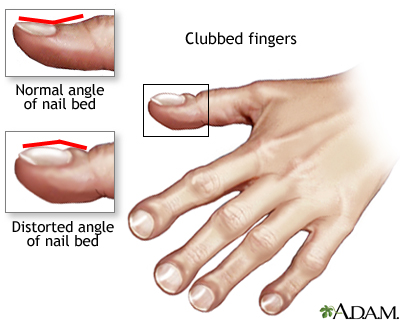Health Library
Clubbing of the fingers or toes
Clubbing
Clubbing is changes in the areas under and around the toenails and fingernails that occur with some disorders. The nails also show changes.
Images


I Would Like to Learn About:
Considerations
Common symptoms of clubbing:
- The nail beds soften. The nails may seem to "float" instead of being firmly attached.
- The nails form a sharper angle with the cuticle.
- The last part of the finger may appear large or bulging. It may also be warm and red.
- The nail curves downward so it looks like the round part of an upside-down spoon.
Clubbing can develop quickly, often within weeks. It also can go away quickly when its cause is treated.
Causes
Lung cancer is the most common cause of clubbing. Clubbing often occurs in heart and lung diseases that reduce the amount of oxygen in the blood. These may include:
- Heart defects that are present at birth (congenital)
- Chronic lung infections that occur in people with bronchiectasis, cystic fibrosis, or lung abscess
- Infection of the lining of the heart chambers and heart valves (infectious endocarditis). This can be caused by bacteria, fungi, or other infectious substances
- Lung disorders in which the deep lung tissues become swollen and then scarred (interstitial lung disease)
Other causes of clubbing:
- Celiac disease
- Cirrhosis of the liver and other liver diseases
- Dysentery
- Graves disease
- Overactive thyroid gland
- Other types of cancer, including liver, gastrointestinal, Hodgkin lymphoma
When to Contact a Medical Professional
If you notice clubbing, call your health care provider.
What to Expect at Your Office Visit
A person with clubbing often has symptoms of another condition. Diagnosing that condition is based on:
- Family history
- Medical history
- Physical exam that looks at the lungs and chest
The provider may ask questions such as:
- Do you have any trouble breathing?
- Do you have clubbing of the fingers, toes, or both?
- When did you first notice this? Do you think it is getting worse?
- Does the skin ever have a blue color?
- What other symptoms do you have?
The following tests may be done:
- Arterial blood gas
- Chest CT scan
- Chest x-ray
- Echocardiogram
- Electrocardiogram (ECG)
- Pulmonary function tests
There is no treatment for the clubbing itself. The cause of clubbing can be treated, however.
Related Information
Blue discoloration of the skinReferences
Drake WM, Chowdhury TA. General patient examination and differential diagnosis. In: Glynn M, Drake WM, eds. Hutchison's Clinical Methods. 24th ed. Philadelphia, PA: Elsevier; 2018:chap 2.
Fajardo E, Davis JL. History and physical examination. In: Broaddus VC, Ernst JD, King TE, Lazarus SC, Sarmiento KF, Schnapp LM, Stapleton RD, eds. Murray and Nadel's Textbook of Respiratory Medicine. 7th ed. Philadelphia, PA: Elsevier; 2022:chap 18.
Kliegman RM, St. Geme JW, Blum NJ, Shah SS, Tasker RC, Wilson KM. Cyanotic congenital heart lesions: lesions associated with decreased pulmonary blood flow. In: Kliegman RM, St. Geme JW, Blum NJ, Shah SS, Tasker RC, Wilson KM, eds. Nelson Textbook of Pediatrics. 21st ed. Philadelphia, PA: Elsevier; 2020:chap 457.
BACK TO TOPReview Date: 5/24/2021
Reviewed By: Neil K. Kaneshiro, MD, MHA, Clinical Professor of Pediatrics, University of Washington School of Medicine, Seattle, WA. Also reviewed by David Zieve, MD, MHA, Medical Director, Brenda Conaway, Editorial Director, and the A.D.A.M. Editorial team.
 | A.D.A.M., Inc. is accredited by URAC, for Health Content Provider (www.urac.org). URAC's accreditation program is an independent audit to verify that A.D.A.M. follows rigorous standards of quality and accountability. A.D.A.M. is among the first to achieve this important distinction for online health information and services. Learn more about A.D.A.M.'s editorial policy, editorial process and privacy policy. A.D.A.M. is also a founding member of Hi-Ethics. This site complies with the HONcode standard for trustworthy health information: verify here. |
The information provided herein should not be used during any medical emergency or for the diagnosis or treatment of any medical condition. A licensed medical professional should be consulted for diagnosis and treatment of any and all medical conditions. Links to other sites are provided for information only -- they do not constitute endorsements of those other sites. © 1997- 2021 A.D.A.M., a business unit of Ebix, Inc. Any duplication or distribution of the information contained herein is strictly prohibited.
